Colon polyps pathophysiology: Difference between revisions
m (Bot: Removing from Primary care) |
|||
| (22 intermediate revisions by 2 users not shown) | |||
| Line 4: | Line 4: | ||
{{CMG}}; {{AE}} {{SSH}} | {{CMG}}; {{AE}} {{SSH}} | ||
==Overview== | ==Overview== | ||
Any form of unregulated growth in the [[Colon (anatomy)|colon]] may cause polyps. The exact etiology is unclear. However, risk factors may contribute to the formation of polyps. There are four different types of polyps including [[Inflammation|inflammatory]], [[Hamartoma|hamartomatous]], serrated, and adenomatous polyps, which have different [[pathogenesis]]. [[Inflammation|Inflammatory]] polyps are non-neoplastic polyps that occur following [[Intestine|intestinal]] [[inflammation]], [[Infection|infections]], or [[ischemia]]. [[Hamartoma|Hamartomatous]] polyp is an overgrowth of mature [[Cell (biology)|cells]] and [[connective tissue]] elements including [[smooth muscle]], [[lamina propria]], and [[cartilage]], and [[fat]]. They are covered by a hypertrophic [[epithelium]]. Serrated polyps are different [[Polyp|polyps]] which have variable [[Malignant|malignant potential]]. They include [[Hyperplasia|hyperplastic]], sessile serrated and traditional serrated polyps. [[Hyperplasia|Hyperplastic]] polyps are the most common [[Polyp|polyps]]. [[Hyperplasia|Hyperplastic]] polyp is infolding of the [[Crypt (anatomy)|crypt]] [[epithelium]] that forms serration or saw-toothed appearance. Sessile serrated polyps are flask-shaped crypts, with dilatation and branching but not pedunculated. Traditional serrated adenomas are serrated polyps that are protuberant and pedunculated, which are located in left [[Colon (anatomy)|colon]]. Traditional adenoma also known as conventional [[Polyp|polyps]], are developed throughout the [[Colon (anatomy)|colon]]. They are the most prevalent polyps that have [[malignant]] potential. | |||
==Pathophysiology== | ==Pathophysiology== | ||
*Any form of unregulated growth in the [[Colon (anatomy)|colon]] may cause polyps. The exact etiology is unclear. However, risk factors may contribute to the formation of polyps.<ref name="pmid18314605">{{cite journal |vauthors=Rüschoff J, Aust D, Hartmann A |title=[Colorectal serrated adenoma: diagnostic criteria and clinical implications] |language=German |journal=Verh Dtsch Ges Pathol |volume=91 |issue= |pages=119–25 |year=2007 |pmid=18314605 |doi= |url=}}</ref><ref name="ShussmanWexner2014">{{cite journal|last1=Shussman|first1=N.|last2=Wexner|first2=S. D.|title=Colorectal polyps and polyposis syndromes|journal=Gastroenterology Report|volume=2|issue=1|year=2014|pages=1–15|issn=2052-0034|doi=10.1093/gastro/got041}}</ref><ref name="SinghZorrón Cheng Tao Pu2016">{{cite journal|last1=Singh|first1=Rajvinder|last2=Zorrón Cheng Tao Pu|first2=Leonardo|last3=Koay|first3=Doreen|last4=Burt|first4=Alastair|title=Sessile serrated adenoma/polyps: Where are we at in 2016?|journal=World Journal of Gastroenterology|volume=22|issue=34|year=2016|pages=7754|issn=1007-9327|doi=10.3748/wjg.v22.i34.7754}}</ref><ref name="KahiVemulapalli2015">{{cite journal|last1=Kahi|first1=Charles J.|last2=Vemulapalli|first2=Krishna C.|last3=Snover|first3=Dale C.|last4=Abdel Jawad|first4=Khaled H.|last5=Cummings|first5=Oscar W.|last6=Rex|first6=Douglas K.|title=Findings in the Distal Colorectum Are Not Associated With Proximal Advanced Serrated Lesions|journal=Clinical Gastroenterology and Hepatology|volume=13|issue=2|year=2015|pages=345–351|issn=15423565|doi=10.1016/j.cgh.2014.07.044}}</ref> | |||
*Any form of unregulated growth in the [[Colon (anatomy)|colon]] may cause polyps. The exact etiology is unclear. However, risk factors may contribute to the formation of polyps. | |||
*There are four different types of polyps including [[Inflammation|inflammatory]], [[Hamartoma|hamartomatous]], serrated, and adenomatous polyps, which have different [[pathogenesis]]. | *There are four different types of polyps including [[Inflammation|inflammatory]], [[Hamartoma|hamartomatous]], serrated, and adenomatous polyps, which have different [[pathogenesis]]. | ||
*The [[pathophysiology]] of colon polyps depends on the [[Histology|histological]] type. | *The [[pathophysiology]] of colon polyps depends on the [[Histology|histological]] type. | ||
| Line 26: | Line 25: | ||
* Solitary polyps has no significant risk of [[cancer]]. However, multiple polyps of the colon have a 10% risk of [[Cancer|malignancy]]. | * Solitary polyps has no significant risk of [[cancer]]. However, multiple polyps of the colon have a 10% risk of [[Cancer|malignancy]]. | ||
==== Serrated polyps ==== | ==== Serrated polyps ==== | ||
* Serrated polyps are different [[Polyp|polyps]] which have variable [[Malignant|malignant potential]]. They include [[Hyperplasia|hyperplastic]], sessile serrated and traditional serrated polyps. They have various histopathologies and manifestations | * Serrated polyps are different [[Polyp|polyps]] which have variable [[Malignant|malignant potential]]. They include [[Hyperplasia|hyperplastic]], sessile serrated and traditional serrated polyps. They have various histopathologies and manifestations: | ||
** [[Hyperplasia|Hyperplastic]] polyps are the most common [[Polyp|polyps]]. | ** [[Hyperplasia|Hyperplastic]] polyps are the most common [[Polyp|polyps]]. | ||
*** They are small outpouching, less than 5 mm, which are located mostly in rectosigmoid area. | *** They are small outpouching, less than 5 mm, which are located mostly in rectosigmoid area. | ||
*** [[Hyperplasia|Hyperplastic]] polyp is infolding of the [[Crypt (anatomy)|crypt]] [[epithelium]] that forms serration or saw-toothed appearance. | *** [[Hyperplasia|Hyperplastic]] polyp is infolding of the [[Crypt (anatomy)|crypt]] [[epithelium]] that forms serration or saw-toothed appearance. | ||
*** The molecular basis of this transformation is still unclear. However, it has been attributed to failure of [[apoptosis]]. | *** The molecular basis of this transformation is still unclear. However, it has been attributed to failure of [[apoptosis]]. | ||
*** [[BRAF]] mutations are associated with crypt serration. | *** [[BRAF]] mutations are associated with crypt serration.<ref name="pmid15247181">{{cite journal |vauthors=Kambara T, Simms LA, Whitehall VL, Spring KJ, Wynter CV, Walsh MD, Barker MA, Arnold S, McGivern A, Matsubara N, Tanaka N, Higuchi T, Young J, Jass JR, Leggett BA |title=BRAF mutation is associated with DNA methylation in serrated polyps and cancers of the colorectum |journal=Gut |volume=53 |issue=8 |pages=1137–44 |year=2004 |pmid=15247181 |pmc=1774130 |doi=10.1136/gut.2003.037671 |url=}}</ref> | ||
*** There are three different subtypes of [[Hyperplasia|hyperplastic]] polyps based on degree of serration and content, including microvesicular type, goblet cell–rich type, and mucin-poor type. | *** There are three different subtypes of [[Hyperplasia|hyperplastic]] polyps based on degree of serration and content, including microvesicular type, goblet cell–rich type, and mucin-poor type. | ||
** Sessile serrated polyps | ** Sessile serrated polyps: | ||
** Traditional serrated adenomas | *** They are flask-shaped crypts, with dilatation and branching but not pedunculated.<ref name="BettingtonWalker2013">{{cite journal|last1=Bettington|first1=Mark|last2=Walker|first2=Neal|last3=Clouston|first3=Andrew|last4=Brown|first4=Ian|last5=Leggett|first5=Barbara|last6=Whitehall|first6=Vicki|title=The serrated pathway to colorectal carcinoma: current concepts and challenges|journal=Histopathology|volume=62|issue=3|year=2013|pages=367–386|issn=03090167|doi=10.1111/his.12055}}</ref><ref name="O'ConnellCrockett2017">{{cite journal|last1=O'Connell|first1=Brendon M|last2=Crockett|first2=Seth D|title=The clinical impact of serrated colorectal polyps|journal=Clinical Epidemiology|volume=Volume 9|year=2017|pages=113–125|issn=1179-1349|doi=10.2147/CLEP.S106257}}</ref> | ||
*** They are protuberant and pedunculated polyps, less than 1.5 cm, which are located in left colon. | *** Crypts grow along muscularis mucosae and creating inverted T- or L-shaped appearance. | ||
* | *** Serration happens at the base and bottom of the crypts. | ||
* | ** Traditional serrated adenomas: | ||
* | *** They are protuberant and pedunculated [[Polyp|polyps]], less than 1.5 cm, which are located in left [[Colon (anatomy)|colon]].<ref name="pmid17516746">{{cite journal |vauthors=Li SC, Burgart L |title=Histopathology of serrated adenoma, its variants, and differentiation from conventional adenomatous and hyperplastic polyps |journal=Arch. Pathol. Lab. Med. |volume=131 |issue=3 |pages=440–5 |year=2007 |pmid=17516746 |doi=10.1043/1543-2165(2007)131[440:HOSAIV]2.0.CO;2 |url=}}</ref> | ||
*** They have [[Cell biology|cytological]] [[dysplasia]] including [[Cell nucleus|nuclear]] transformation, irregular [[Cell nucleus|nuclear]] polarity, and serration. | |||
*** [[Cell biology|Cytological]] [[dysplasia]] causes crypts that are irregular and branching. | |||
==== Adenomatous polyps ==== | ==== Adenomatous polyps ==== | ||
* | *Traditional adenoma also known as conventional [[Polyp|polyps]], are developed throughout the [[Colon (anatomy)|colon]]. | ||
*They are the most prevalent polyps that have [[malignant]] potential. | |||
* | *They have different gross appearances including [[pedunculated]], [[sessile]], flat, or depressed. | ||
*They might have different [[Histopathology|histopathologies]] including tubular, villous, or tubulovillous. | |||
* | |||
==Genetics== | ==Genetics== | ||
| Line 53: | Line 52: | ||
==== '''[[Familial adenomatous polyposis]] ([[FAP]])''' ==== | ==== '''[[Familial adenomatous polyposis]] ([[FAP]])''' ==== | ||
* FAP is due to mutations in the following genes: | * FAP is due to mutations in the following genes: | ||
** ''[[APC (gene)|APC]]'' gene, which is located on [[chromosome]] 5 in band q21 or band q22 (5q21-q22) | ** ''[[APC (gene)|APC]]'' gene, which is located on [[chromosome]] 5 in band q21 or band q22 (5q21-q22). | ||
** ''[[MUTYH]]'' gene, which is located on chromosome 1 between bands p34.2 and p32.1 (5p34.3-p32.1) | ** ''[[MUTYH]]'' gene, which is located on chromosome 1 between bands p34.2 and p32.1 (5p34.3-p32.1). | ||
** MYH-associated polyposis (MAP) is caused by mutations in the MYH gene. | ** MYH-associated polyposis (MAP) is caused by mutations in the MYH gene. | ||
'''[[Peutz-Jeghers syndrome]]''' | '''[[Peutz-Jeghers syndrome]]''' | ||
| Line 65: | Line 64: | ||
==== Familial juvenile polyposis ==== | ==== Familial juvenile polyposis ==== | ||
*It is an autosomal dominant disorder. | *It is an autosomal dominant disorder. | ||
*It increases risk of colorectal cancer | *It increases risk of colorectal cancer. | ||
*It has extra-colonic tumors. | *It has extra-colonic tumors. | ||
*There has been some association with the following genes: | *There has been some association with the following genes: | ||
**SMAD4 on [[Chromosome 18 (human)|chromosome 18]] | **SMAD4 on [[Chromosome 18 (human)|chromosome 18]]. | ||
**PTEN on [[Chromosome 10 (human)|chromosome 10]] | **PTEN on [[Chromosome 10 (human)|chromosome 10]]. | ||
==Gross Pathology== | ==Gross Pathology== | ||
*On gross pathology, outpouching, pedunculated or flat lesions are characteristic findings of colon polyps. | *On gross [[pathology]], outpouching, pedunculated or flat lesions are characteristic findings of colon polyps. | ||
*On gross [[pathology]], colon polyps may have a short or long stalk. | |||
*The polyp might have hemorrhagic stalk and colon wall with pale ribbon of mucosal covering. | |||
{| | {| | ||
|[[Image:Villous_adenoma_of_the_sigmoid_colon,_gross_pathology.jpg|thumb|left|Villous | |[[Image:Villous_adenoma_of_the_sigmoid_colon,_gross_pathology.jpg|thumb|left|Villous [[Adenoma]] of the [[Transverse colon]] By http://web2.airmail.net/uthman/specimens/index.html, Public Domain, https://commons.wikimedia.org/w/index.php?curid=840194]] | ||
|- | |- | ||
|[[Image:Tvp_enface.jpg|thumb|left|Tubulovillous Polyp of the Colon By http://web2.airmail.net/uthman/specimens/index.html, Public Domain, https://commons.wikimedia.org/w/index.php?curid=840172]] | |[[Image:Tvp_enface.jpg|thumb|left|Tubulovillous Polyp of the [[Colon (anatomy)|Colon]] By http://web2.airmail.net/uthman/specimens/index.html, Public Domain, https://commons.wikimedia.org/w/index.php?curid=840172]] | ||
|- | |- | ||
|[[Image:Tubulovillous_polyp_of_the_colon.jpg|thumb|left|Tubulovillous Polyp of the Colon By http://web2.airmail.net/uthman/specimens/index.html, Public Domain, https://commons.wikimedia.org/w/index.php?curid=840176]] | |[[Image:Tubulovillous_polyp_of_the_colon.jpg|thumb|left|Tubulovillous Polyp of the [[Colon (anatomy)|Colon]] By http://web2.airmail.net/uthman/specimens/index.html, Public Domain, https://commons.wikimedia.org/w/index.php?curid=840176]] | ||
|- | |- | ||
|[[Image:Adenomatous_Polyp_of_the_Colon_1.jpg|thumb|left|Adenomatous Polyp of the Colon By http://web2.airmail.net/uthman/specimens/index.html, Public Domain, https://commons.wikimedia.org/w/index.php?curid=840154]] | |[[Image:Adenomatous_Polyp_of_the_Colon_1.jpg|thumb|left|Adenomatous Polyp of the [[Colon (anatomy)|Colon]] By http://web2.airmail.net/uthman/specimens/index.html, Public Domain, https://commons.wikimedia.org/w/index.php?curid=840154]] | ||
|- | |- | ||
|[[Image:Adenomatous_polyp_of_colon_2.jpg|thumb|left|Adenomatous Polyp of the Colon By http://web2.airmail.net/uthman/specimens/index.html, Public Domain, https://commons.wikimedia.org/w/index.php?curid=840157]] | |[[Image:Adenomatous_polyp_of_colon_2.jpg|thumb|left|Adenomatous Polyp of the [[Colon (anatomy)|Colon]] By http://web2.airmail.net/uthman/specimens/index.html, Public Domain, https://commons.wikimedia.org/w/index.php?curid=840157]] | ||
|- | |- | ||
|[[image:Image of resected colon segment with cancer & 4 nearby polyps plus schematic of field defects with sub-clones.jpg|thumb|left|Longitudinally opened freshly resected colon segment showing | |[[image:Image of resected colon segment with cancer & 4 nearby polyps plus schematic of field defects with sub-clones.jpg|thumb|left|Longitudinally opened freshly resected [[Colon (anatomy)|colon]] segment showing [[cancer]] and four [[Polyp|polyps]]. Plus a schematic diagram indicating a likely field defect (a region of [[Tissue (biology)|tissue]] that precedes and predisposes to the development of [[cancer]]) in this [[Colon (anatomy)|colon]] segment. The diagram indicates sub-clones and sub-sub-clones that were precursors to the [[Tumor|tumors]]. Source: Wikimedia.org By Bernstein0275 - Own work, CC BY-SA 3.0<ref name="urlFile:Image of resected colon segment with cancer & 4 nearby polyps plus schematic of field defects with sub-clones.jpg - Wikimedia Commons">{{cite web |url=https://commons.wikimedia.org/w/index.php?curid=25453056 |title=File:Image of resected colon segment with cancer & 4 nearby polyps plus schematic of field defects with sub-clones.jpg - Wikimedia Commons |format= |work= |accessdate=}}</ref>]] | ||
|- | |- | ||
|[[Image:Colon-Polyp.jpg|thumb|left|Colon polyp on | |[[Image:Colon-Polyp.jpg|thumb|left|Colon polyp on [[Colonoscopy]] By 邱鈺鋒 - Own work, CC BY-SA 4.0, https://commons.wikimedia.org/w/index.php?curid=37027826]] | ||
|- | |||
|[[Image:Endomucosal resection 1.jpg|thumb|left|[[Endoscopy|Endoscopic]] image, 1 of 4, of an endomucosal resection of a sessile colon polyp By The original uploader was Kd4ttc at English Wikipedia - Transferred from en.wikipedia to Commons., CC BY 2.5, https://commons.wikimedia.org/w/index.php?curid=2175689]] | |||
|- | |- | ||
|} | |} | ||
==Microscopic Pathology== | ==Microscopic Pathology== | ||
[[Image:Hyperplastic_polyp_of_the_colon,_HE.png|thumb|left|Hyperplastic polyp of the Colon. By Patho - Own work, CC BY-SA 3.0, https://commons.wikimedia.org/w/index.php?curid=19409502]] | *On microscopic [[Histopathology|histopathological]] analysis, serration of the luminal surface and normal [[Cell nucleus|nuclei]] are characteristic findings of hyperplastic polyps. | ||
[[Image:Hyperplastic_polyp2.jpg|thumb|left|Micrograph of a colorectal hyperplastic polyp. H&E stain. By Nephron - Own work, CC BY-SA 3.0, https://commons.wikimedia.org/w/index.php?curid=6427545]] | *On microscopic [[Histopathology|histopathological]] analysis, branched tubular glands are characteristic findings of tubular [[adenoma]]. | ||
[[Image:Colon_adenoma_(1).jpg|thumb|left|Colon adenoma By No machine-readable author provided. KGH assumed (based on copyright claims). - No machine-readable source provided. Own work assumed (based on copyright claims)., CC BY-SA 3.0, https://commons.wikimedia.org/w/index.php?curid=444694]] | *On microscopic [[Histopathology|histopathological]] analysis, long finger-like projections are characteristic findings of villous [[adenoma]]. | ||
*On microscopic [[Histopathology|histopathological]] analysis, branched and dilated [[Gland|glands]], no [[Cell biology|cytological]] [[atypia]], [[eosinophilic]] [[cytoplasm]], and luminal [[Epithelium|epithelial]] tufting are characteristic findings of sessile serrated [[adenoma]]. | |||
[[Image:Hyperplastic_polyp_of_the_colon,_HE.png|thumb|left|Hyperplastic polyp of the [[Colon (anatomy)|Colon]]. By Patho - Own work, CC BY-SA 3.0, https://commons.wikimedia.org/w/index.php?curid=19409502]] | |||
[[Image:Hyperplastic_polyp2.jpg|thumb|left|Micrograph of a [[Colon (anatomy)|colorectal]] hyperplastic polyp. [[H&E stain]]. By Nephron - Own work, CC BY-SA 3.0, https://commons.wikimedia.org/w/index.php?curid=6427545]] | |||
[[Image:Colon_adenoma_(1).jpg|thumb|left|[[Colon (anatomy)|Colon]] [[adenoma]] By No machine-readable author provided. KGH assumed (based on copyright claims). - No machine-readable source provided. Own work assumed (based on copyright claims)., CC BY-SA 3.0, https://commons.wikimedia.org/w/index.php?curid=444694]] | |||
<br style="clear:left" /> | <br style="clear:left" /> | ||
| Line 100: | Line 106: | ||
{{Reflist|2}} | {{Reflist|2}} | ||
| | ||
| |||
[[Category:Medicine]] | [[Category:Medicine]] | ||
[[Category:Gastroenterology]] | [[Category:Gastroenterology]] | ||
[[Category:Up-To-Date]] | [[Category:Up-To-Date]] | ||
Latest revision as of 21:01, 29 July 2020
|
Colon polyps Microchapters |
|
Diagnosis |
|---|
|
Treatment |
|
Case Studies |
|
Colon polyps pathophysiology On the Web |
|
American Roentgen Ray Society Images of Colon polyps pathophysiology |
|
Risk calculators and risk factors for Colon polyps pathophysiology |
Editor-In-Chief: C. Michael Gibson, M.S., M.D. [1]; Associate Editor(s)-in-Chief: Sadaf Sharfaei M.D.[2]
Overview
Any form of unregulated growth in the colon may cause polyps. The exact etiology is unclear. However, risk factors may contribute to the formation of polyps. There are four different types of polyps including inflammatory, hamartomatous, serrated, and adenomatous polyps, which have different pathogenesis. Inflammatory polyps are non-neoplastic polyps that occur following intestinal inflammation, infections, or ischemia. Hamartomatous polyp is an overgrowth of mature cells and connective tissue elements including smooth muscle, lamina propria, and cartilage, and fat. They are covered by a hypertrophic epithelium. Serrated polyps are different polyps which have variable malignant potential. They include hyperplastic, sessile serrated and traditional serrated polyps. Hyperplastic polyps are the most common polyps. Hyperplastic polyp is infolding of the crypt epithelium that forms serration or saw-toothed appearance. Sessile serrated polyps are flask-shaped crypts, with dilatation and branching but not pedunculated. Traditional serrated adenomas are serrated polyps that are protuberant and pedunculated, which are located in left colon. Traditional adenoma also known as conventional polyps, are developed throughout the colon. They are the most prevalent polyps that have malignant potential.
Pathophysiology
- Any form of unregulated growth in the colon may cause polyps. The exact etiology is unclear. However, risk factors may contribute to the formation of polyps.[1][2][3][4]
- There are four different types of polyps including inflammatory, hamartomatous, serrated, and adenomatous polyps, which have different pathogenesis.
- The pathophysiology of colon polyps depends on the histological type.
{{#ev:youtube|oJU7CokNLZY}} {{#ev:youtube|7n5EnaLOV54}}
Inflammatory polyps
- Inflammatory polyps are non-neoplastic polyps that occur following intestinal inflammation, infections, or ischemia.[2][5]
- They mostly occur in patients with inflammatory bowel disease, mainly ulcerative colitis.
- They are considered as pseudopolyps which contain inflammatory infiltrations with distorted mucosa.
- It had no malignant potential. However, it is recommended to biopsy the lesion and surrounding mucosa.
- Microscopic pathology of biopsy shows mixture of normal, ulcerated, and regenerating mucosa which is surrounded by areas of mucosal loss.
Hamartomatous polyps
- Hamartomatous polyp is an overgrowth of mature cells and connective tissue elements including smooth muscle, lamina propria, and cartilage, and fat. They are covered by a hypertrophic epithelium.[6]
- They might be pedunculated, inflamed, or smooth polyps which are solitary or multiple.
- Solitary hamartomatous polyps, also known as juvenile polyps, can present more commonly in younger population.
- Solitary polyps has no significant risk of cancer. However, multiple polyps of the colon have a 10% risk of malignancy.
Serrated polyps
- Serrated polyps are different polyps which have variable malignant potential. They include hyperplastic, sessile serrated and traditional serrated polyps. They have various histopathologies and manifestations:
- Hyperplastic polyps are the most common polyps.
- They are small outpouching, less than 5 mm, which are located mostly in rectosigmoid area.
- Hyperplastic polyp is infolding of the crypt epithelium that forms serration or saw-toothed appearance.
- The molecular basis of this transformation is still unclear. However, it has been attributed to failure of apoptosis.
- BRAF mutations are associated with crypt serration.[7]
- There are three different subtypes of hyperplastic polyps based on degree of serration and content, including microvesicular type, goblet cell–rich type, and mucin-poor type.
- Sessile serrated polyps:
- Traditional serrated adenomas:
- They are protuberant and pedunculated polyps, less than 1.5 cm, which are located in left colon.[5]
- They have cytological dysplasia including nuclear transformation, irregular nuclear polarity, and serration.
- Cytological dysplasia causes crypts that are irregular and branching.
- Hyperplastic polyps are the most common polyps.
Adenomatous polyps
- Traditional adenoma also known as conventional polyps, are developed throughout the colon.
- They are the most prevalent polyps that have malignant potential.
- They have different gross appearances including pedunculated, sessile, flat, or depressed.
- They might have different histopathologies including tubular, villous, or tubulovillous.
Genetics
- The development of colon polyps is the result of multiple genetic mutations.
- Genetic mutations might cause hereditary polyps disorders.
Familial adenomatous polyposis (FAP)
- FAP is due to mutations in the following genes:
- APC gene, which is located on chromosome 5 in band q21 or band q22 (5q21-q22).
- MUTYH gene, which is located on chromosome 1 between bands p34.2 and p32.1 (5p34.3-p32.1).
- MYH-associated polyposis (MAP) is caused by mutations in the MYH gene.
- It is thought that Peutz-Jeghers syndrome is the result of deletion or partial deletion of STK11 (LBK1) gene, located on chromosome 19p13.3.
- It is caused by mutation in the APC gene located in chromosome 5q21 (band q21 on chromosome 5).
Serrated polyposis syndrome
- They develop multiple serrated adenomatous polyps in the upper part of the colon.
Familial juvenile polyposis
- It is an autosomal dominant disorder.
- It increases risk of colorectal cancer.
- It has extra-colonic tumors.
- There has been some association with the following genes:
- SMAD4 on chromosome 18.
- PTEN on chromosome 10.
Gross Pathology
- On gross pathology, outpouching, pedunculated or flat lesions are characteristic findings of colon polyps.
- On gross pathology, colon polyps may have a short or long stalk.
- The polyp might have hemorrhagic stalk and colon wall with pale ribbon of mucosal covering.
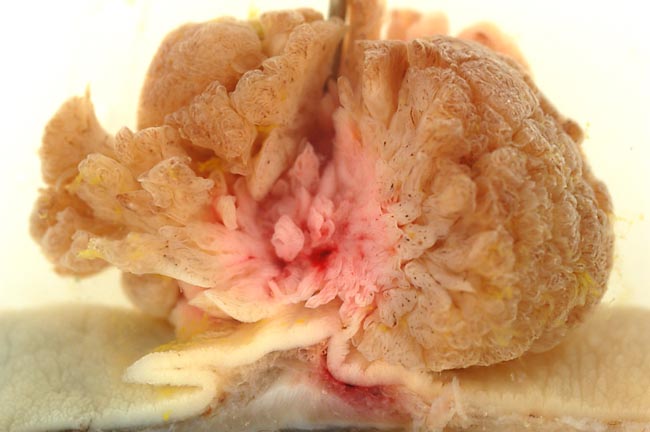 |
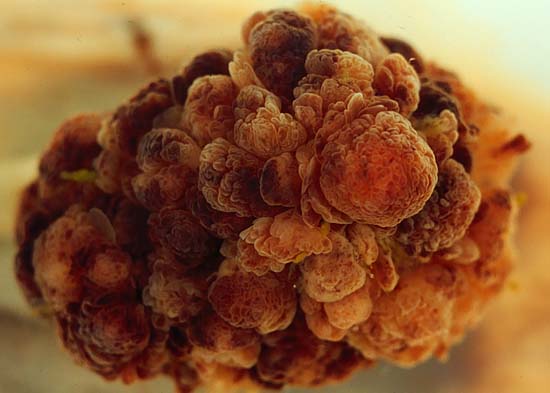 |
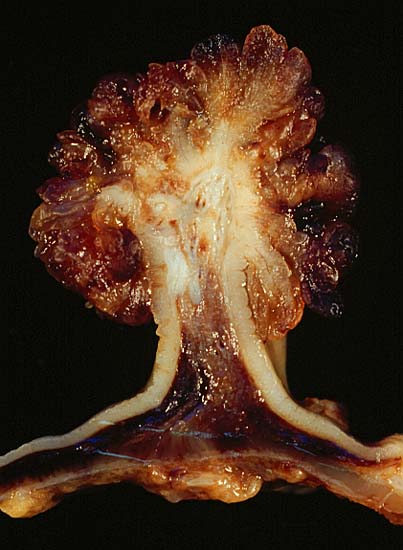 |
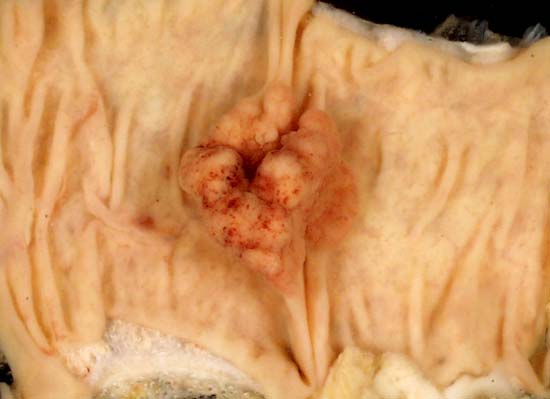 |
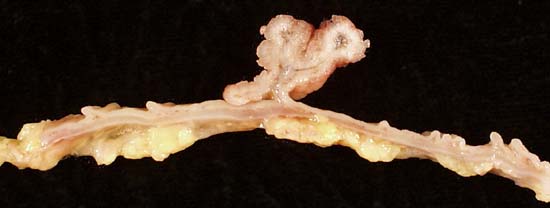 |
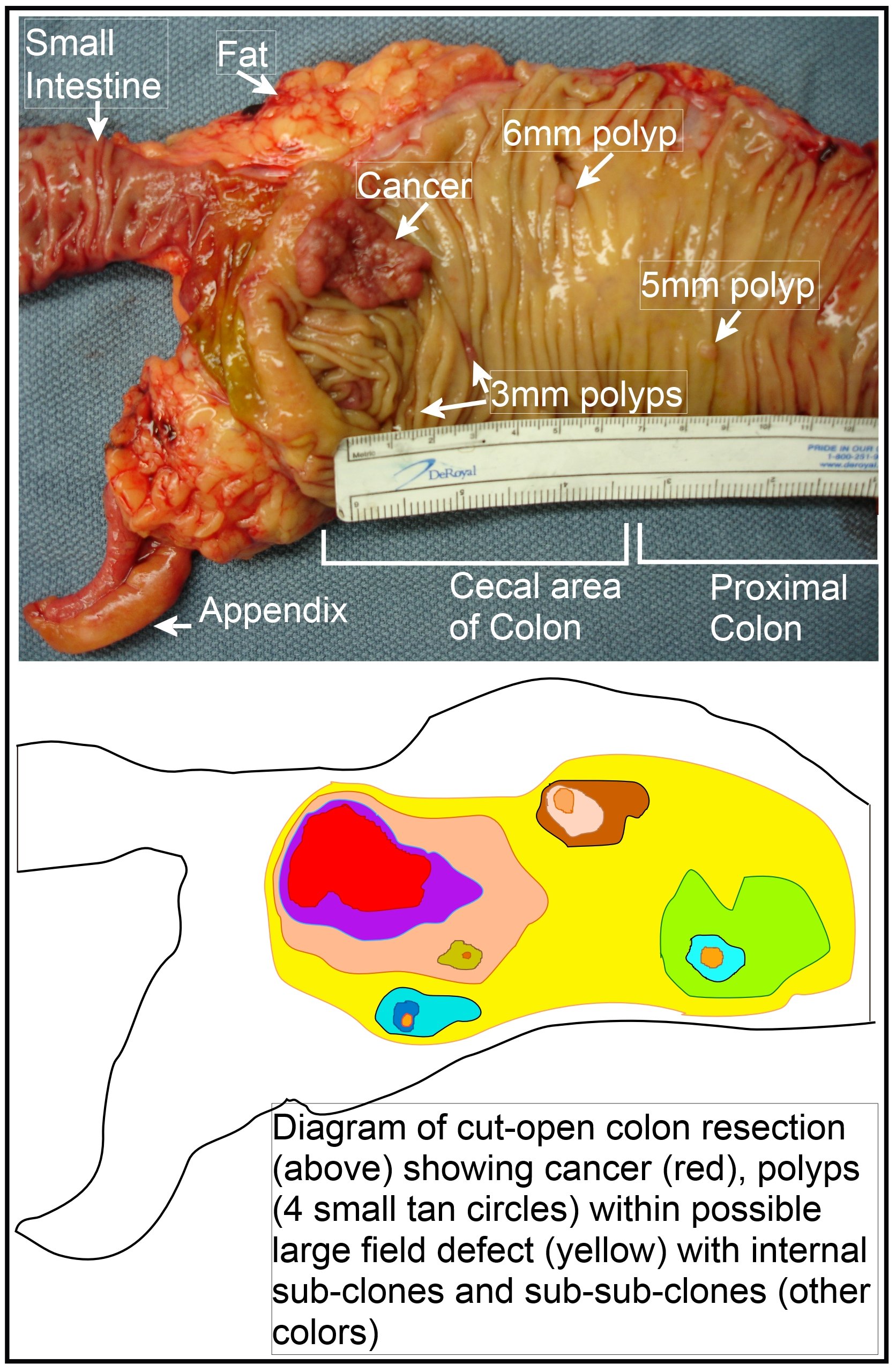 |
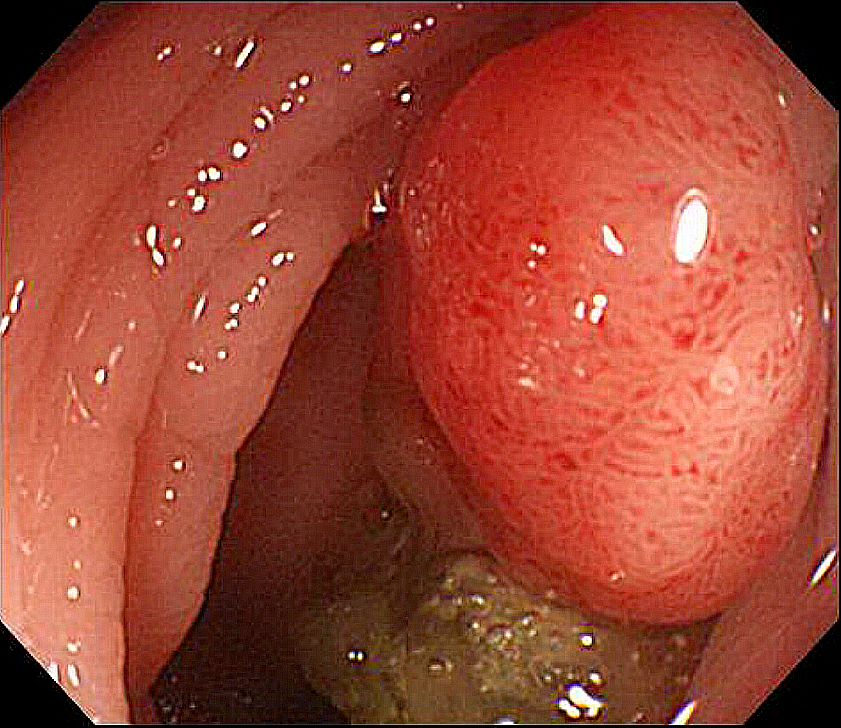 |
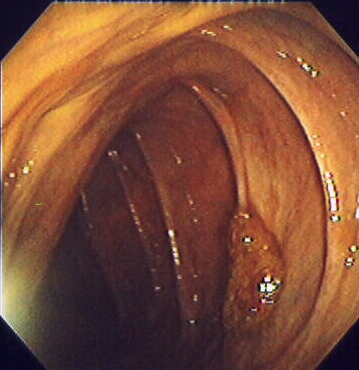 |
Microscopic Pathology
- On microscopic histopathological analysis, serration of the luminal surface and normal nuclei are characteristic findings of hyperplastic polyps.
- On microscopic histopathological analysis, branched tubular glands are characteristic findings of tubular adenoma.
- On microscopic histopathological analysis, long finger-like projections are characteristic findings of villous adenoma.
- On microscopic histopathological analysis, branched and dilated glands, no cytological atypia, eosinophilic cytoplasm, and luminal epithelial tufting are characteristic findings of sessile serrated adenoma.
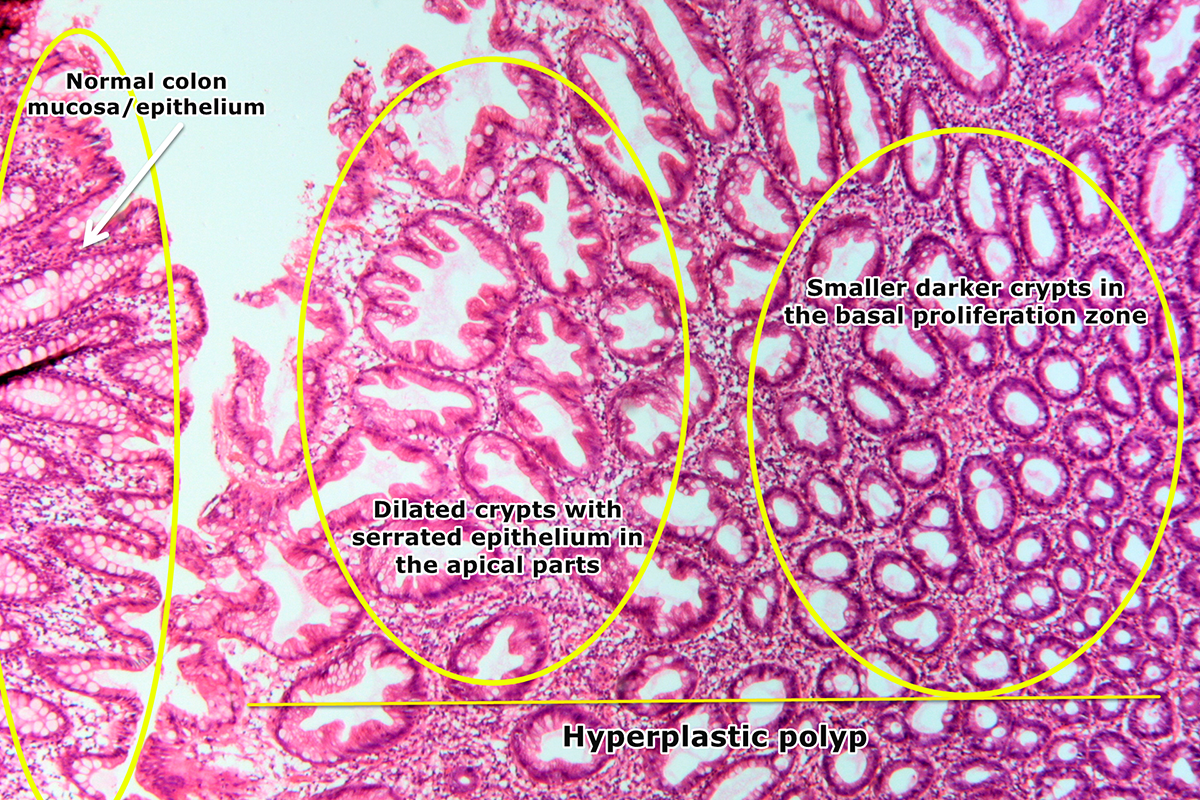
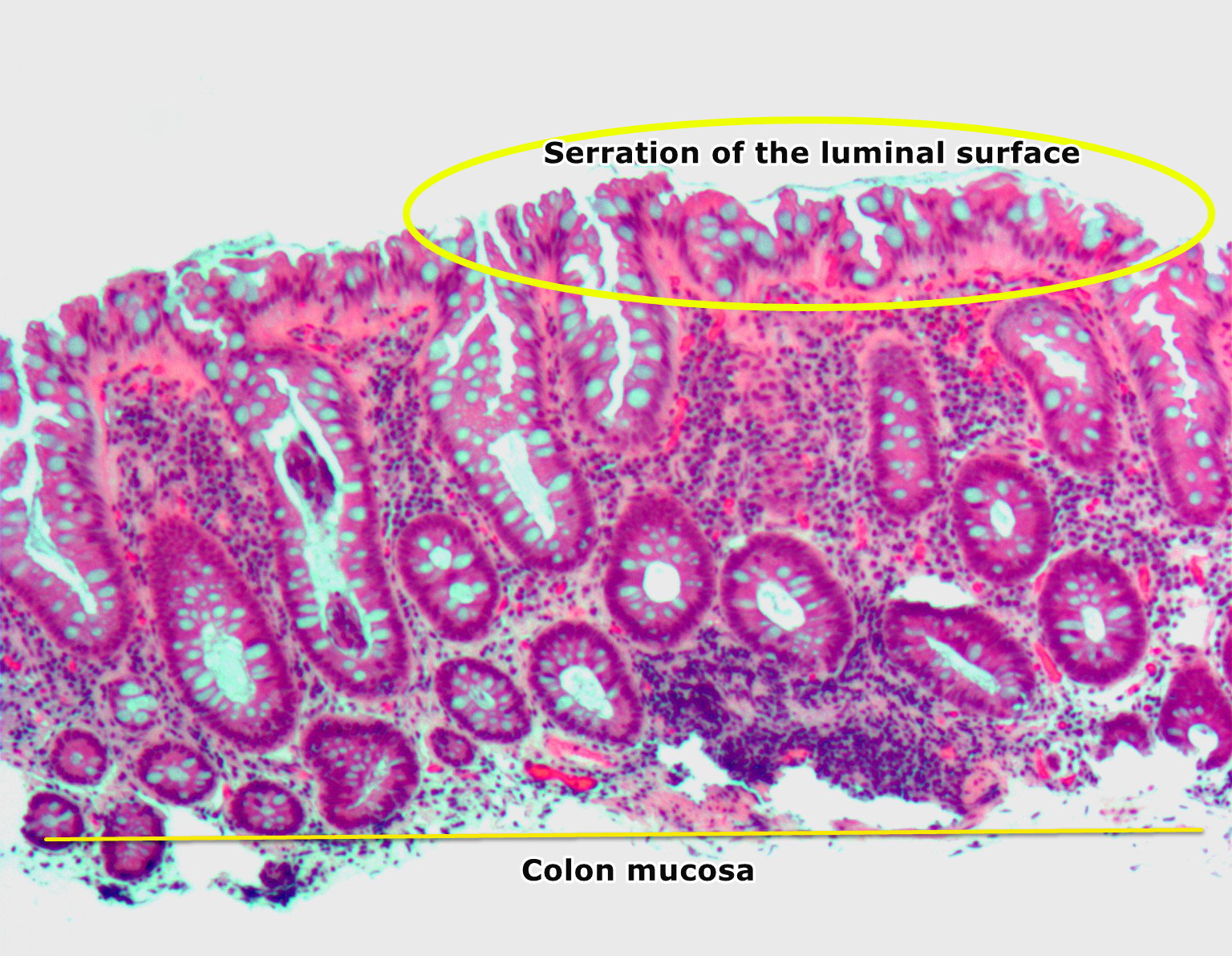
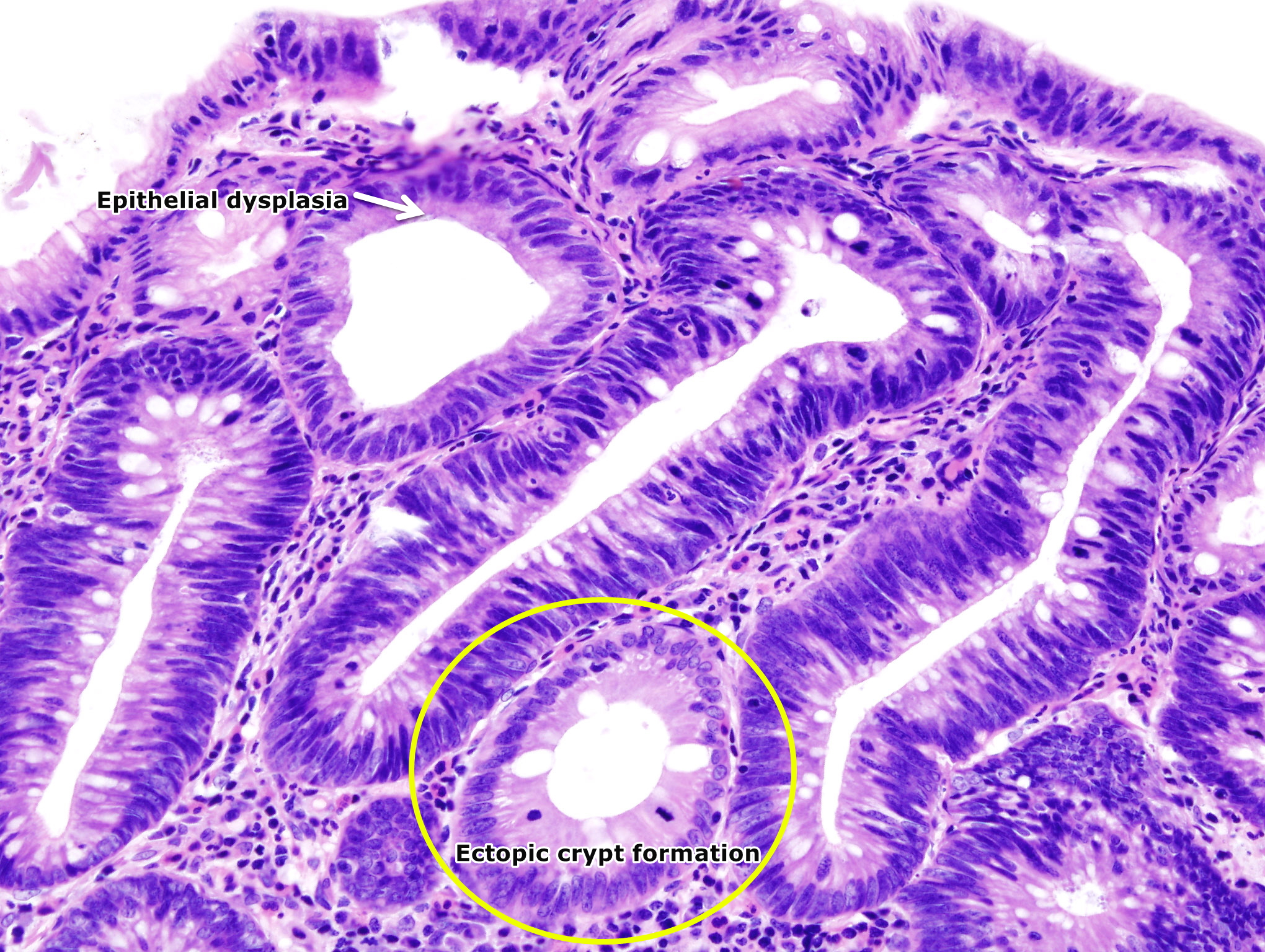
References
- ↑ Rüschoff J, Aust D, Hartmann A (2007). "[Colorectal serrated adenoma: diagnostic criteria and clinical implications]". Verh Dtsch Ges Pathol (in German). 91: 119–25. PMID 18314605.
- ↑ 2.0 2.1 Shussman, N.; Wexner, S. D. (2014). "Colorectal polyps and polyposis syndromes". Gastroenterology Report. 2 (1): 1–15. doi:10.1093/gastro/got041. ISSN 2052-0034.
- ↑ Singh, Rajvinder; Zorrón Cheng Tao Pu, Leonardo; Koay, Doreen; Burt, Alastair (2016). "Sessile serrated adenoma/polyps: Where are we at in 2016?". World Journal of Gastroenterology. 22 (34): 7754. doi:10.3748/wjg.v22.i34.7754. ISSN 1007-9327.
- ↑ Kahi, Charles J.; Vemulapalli, Krishna C.; Snover, Dale C.; Abdel Jawad, Khaled H.; Cummings, Oscar W.; Rex, Douglas K. (2015). "Findings in the Distal Colorectum Are Not Associated With Proximal Advanced Serrated Lesions". Clinical Gastroenterology and Hepatology. 13 (2): 345–351. doi:10.1016/j.cgh.2014.07.044. ISSN 1542-3565.
- ↑ 5.0 5.1 Li SC, Burgart L (2007). "Histopathology of serrated adenoma, its variants, and differentiation from conventional adenomatous and hyperplastic polyps". Arch. Pathol. Lab. Med. 131 (3): 440–5. doi:10.1043/1543-2165(2007)131[440:HOSAIV]2.0.CO;2. PMID 17516746.
- ↑ Zbuk KM, Eng C (2007). "Hamartomatous polyposis syndromes". Nat Clin Pract Gastroenterol Hepatol. 4 (9): 492–502. doi:10.1038/ncpgasthep0902. PMID 17768394.
- ↑ Kambara T, Simms LA, Whitehall VL, Spring KJ, Wynter CV, Walsh MD, Barker MA, Arnold S, McGivern A, Matsubara N, Tanaka N, Higuchi T, Young J, Jass JR, Leggett BA (2004). "BRAF mutation is associated with DNA methylation in serrated polyps and cancers of the colorectum". Gut. 53 (8): 1137–44. doi:10.1136/gut.2003.037671. PMC 1774130. PMID 15247181.
- ↑ Bettington, Mark; Walker, Neal; Clouston, Andrew; Brown, Ian; Leggett, Barbara; Whitehall, Vicki (2013). "The serrated pathway to colorectal carcinoma: current concepts and challenges". Histopathology. 62 (3): 367–386. doi:10.1111/his.12055. ISSN 0309-0167.
- ↑ O'Connell, Brendon M; Crockett, Seth D (2017). "The clinical impact of serrated colorectal polyps". Clinical Epidemiology. Volume 9: 113–125. doi:10.2147/CLEP.S106257. ISSN 1179-1349.
- ↑ "File:Image of resected colon segment with cancer & 4 nearby polyps plus schematic of field defects with sub-clones.jpg - Wikimedia Commons".